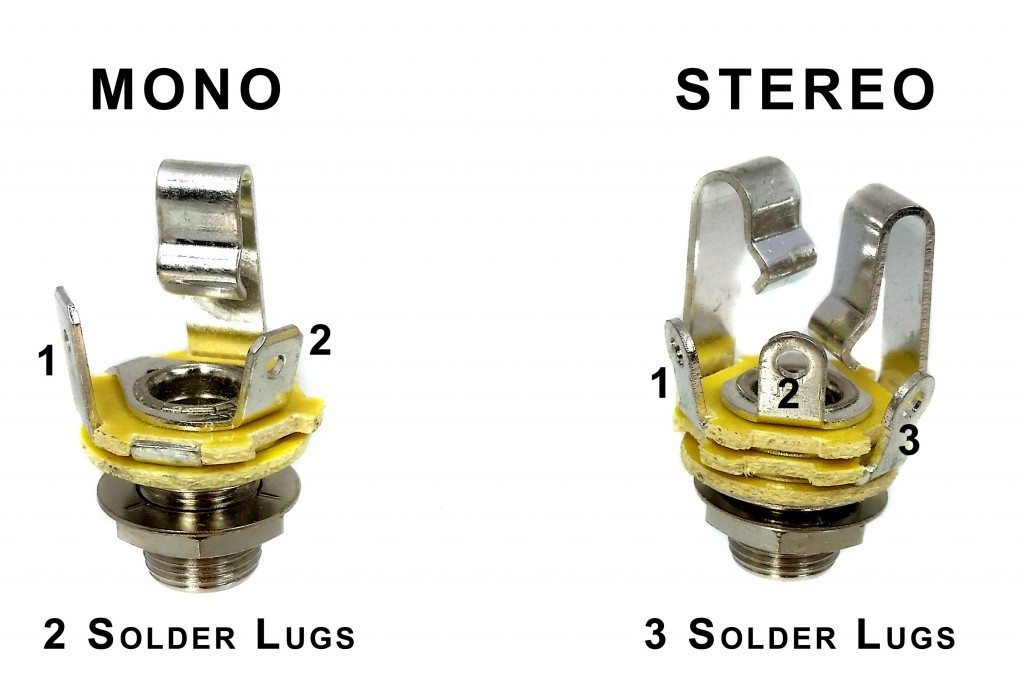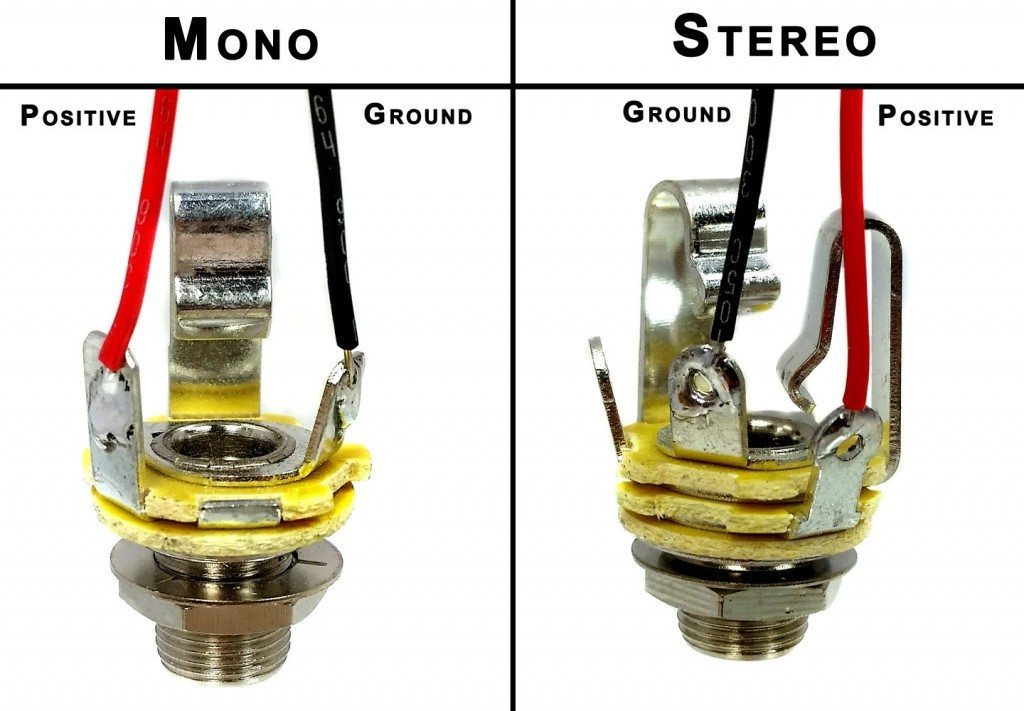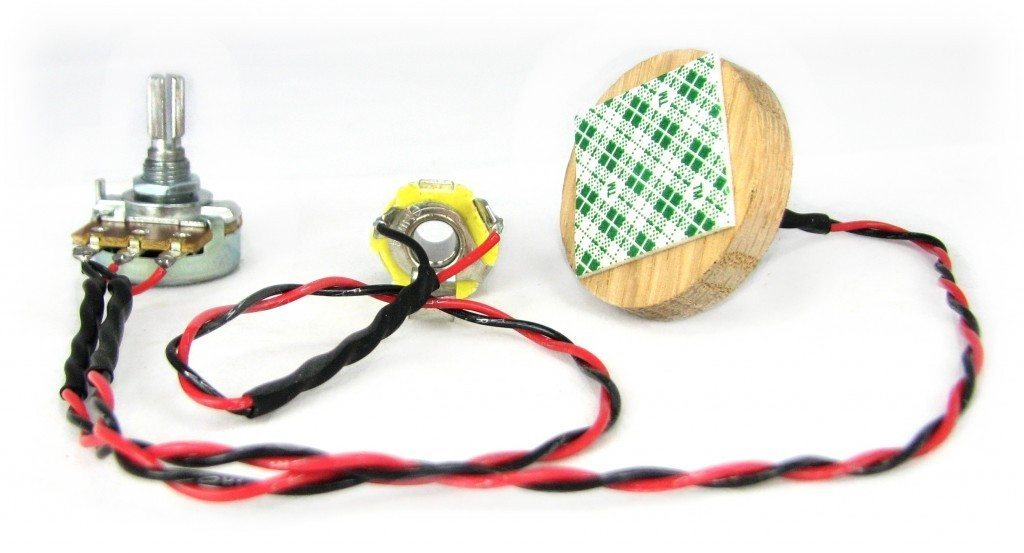In this article we will show you the differences between mono and stereo output jacks, and how to wire them for use on your cigar box guitars.
A lot of folks have questions about wiring jacks: how do you tell mono from stereo, which lug is positive and which is negative, and can you use a stereo jack with a mono cable (the answer is YES, you can – see the final paragraphs below for how).
This article covers “phone” style jacks, which are made to be mounted in a panel via a threaded shaft and nut, with the soldering lugs for attaching wires extending off of the back. They also have one or two “prongs” that stick off of the back and make contact with the tip of the plug.
First, let’s take a look at the differences between a mono an a stereo jack. These photos show the popular Neutrik/Rean brand phone jacks, but these principles apply to jacks from other manufacturers as well
So you can see that the stereo jack has one more solder lug and prong than the mono jack does. This is because to have stereo sound, you need both a left and right channel (so that you can hear different things out of the left and right speakers of your stereo) plus the ground. A mono jack only has a single channel plus the ground, for handling mono sounds – like what guitar pickups put out.
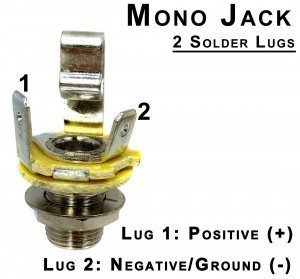 Here is a close look at the mono variety of phone jacks. Click on the photo for a higher resolution photo.
Here is a close look at the mono variety of phone jacks. Click on the photo for a higher resolution photo.
Notice that the longer lug, which if you look closely in between the yellow wafers is connected to the long prong that sticks out of the back, is the positive. The shorter lug, which is connected to the “sleeve” part of the jack which touches the “barrel” of the plug, is the ground/negative.
This is the standard style of jack most often used when installing pickups in cigar box guitars. They are also often used as input jacks on mono amplifiers and other audio equipment.
You can buy these exact Neutrik/REAN brand mono jacks here on CBGitty.com.
We also have “economy” grade mono phone jacks available here, if you want to save a little money.
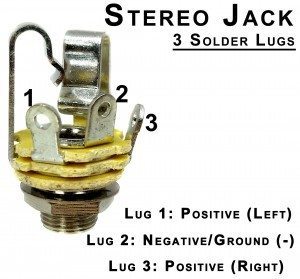 Now for a closer look at the stereo variety. Click on the photo to the right for a higher-resolution version.
Now for a closer look at the stereo variety. Click on the photo to the right for a higher-resolution version.
The stereo jack has the extra lug and prong mentioned above, but otherwise is very similar to the mono jack. If you hold a stereo jack like the one shown in the photo, then from left to right the lugs should be Positive Left, Negative/Ground and Positive Right.
You can verify this by looking carefully in between the yellow wafers that make up the body of the jack. The lug that connects to the longer prong (#3) is the right channel positive. The lug that connects to the shorter of the two prongs (#1) is the left channel positive. The lug that connects to the sleeve that touches the “barrel” of the plug (#2) is the ground/negative.
Now let’s take a look at how they look wired up.
As always, RED is POSITIVE and BLACK is NEGATIVE/GROUND!
The photo above shows how you would wire both jacks for MONO use. Note that lug #1 on the stereo jack has no wire soldered to it. In this configuration, both the mono and stereo jacks could be used on a cigar box guitar with a standard mono amp cord. Once installed no one would be able to tell that it is actually a stereo jack.
If you wanted to wire the stereo jack for actual stereo usage, you would simply solder on another positive lead to lug #1. Some builders sometimes do this if they have more than one pickup in their guitar that they want to hand off to a special amplifier setup, but that is a more advanced topic we don’t need to get into here.
So that’s about it! We hope this article has helped clear up any confusion you may have had about how mono and stereo jacks work, and how to make use of them.
Want a pickup in your guitar, but not interested in all of the wiring and soldering and shenanigans? Try one of C. B. Gitty’s pre-wired pickup harnesses! Click the image below to see what we’ve got…

